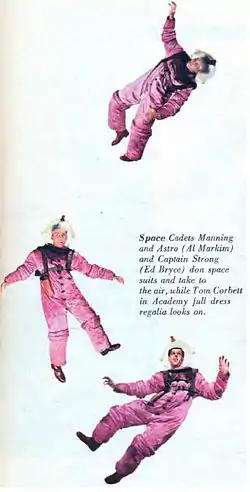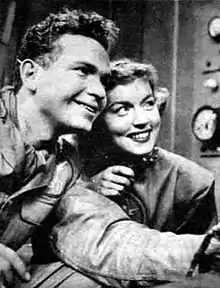Tom Corbett, Space Cadet
Tom Corbett is the main character in a series of Tom Corbett—Space Cadet stories that were depicted in television, radio, books, comic books, comic strips, and other media in the 1950s.
 Frankie Thomas as Tom Corbett | |
| Author | Carey Rockwell |
|---|---|
| Country | United States |
| Language | English |
| Genre | Science fiction novel |
| Publisher | Grosset & Dunlap |
Publication date | 1952 |
The stories followed the adventures of Corbett, Astro, and Roger Manning (originally; later, T.J. Thistle), cadets at the Space Academy as they train to become members of the Solar Guard. The action takes place at the Academy in classrooms and bunkrooms, aboard their training ship the rocket cruiser Polaris, and on alien worlds, both within the solar system and in orbit around nearby stars.[1]
Origin
Joseph Greene of Grosset & Dunlap developed Tom Corbett, Space Cadet, inspired by the Robert A. Heinlein novel Space Cadet (1948)[2] but based on his own prior work. Greene had submitted a radio script for "Tom Ranger" and the "Space Cadets" on January 16, 1946, but it remained unperformed when Heinlein's novel was published. Greene then reworked his radio script into a script for a daily newspaper adventure strip, which was never produced.
Television
| Tom Corbett, Space Cadet | |
|---|---|
 | |
| Created by | Joseph Greene |
| Starring | Frankie Thomas, Al Markim, Jan Merlin, Edward Bryce |
| Release | |
| Original network | CBS (October 2 to December 29, 1950); ABC (January 1, 1951 to September 26, 1952); NBC (July to September 1951, December 1954 to June 25, 1955); DuMont (August 1953 to May 1954) |
| Original release | October 2, 1950 – June 25, 1955 |
Tom Corbett first appeared on television. The stories initially closely followed the scripts written for the unpublished newspaper comic strip Tom Ranger, Space Cadet, by Joseph Greene from 1949.
Tom Corbett is one of only six TV series to appear on all four networks of the time, along with The Arthur Murray Party, Down You Go, The Ernie Kovacs Show, Pantomime Quiz, and The Original Amateur Hour:
- CBS from October 2 to December 1950
- ABC from January 1951 to September 1952
- NBC from July to September 1951
- DuMont from August 1953 to May 1954
- NBC again from December 1954 to June 1955, with the final broadcast on June 25, 1955.[3]
Cast

- Tom Corbett – Frankie Thomas, Jr.
- Astro – Al Markim: A Venusian cadet
- Roger Manning – Jan Merlin: A smug, egotistical cadet with an inordinately high opinion of his own abilities, although he occasionally proved himself to be nearly as skilled as he imagined himself to be. Roger occasionally made condescending, racist remarks about Astro but gradually came to like and respect the Venusian, although he sometimes maintained his bigoted attitude as a distancing mechanism. (October 1950-May 1954)
- Captain Steve Strong – Edward Bryce
- Dr. Joan Dale – Margaret Garland
- Commander Arkwright – Carter Blake
- Cadet Alfie Higgins – John Fiedler
- Cadet Eric Rattison – Frank Sutton
- Cadet T. J. Thistle – Jack Grimes (December 1954-June 1955)
Michael Harvey played Captain Strong for the first six episodes of the CBS series; Pat Ferris played Dr. Dale for two episodes of the DuMont series.
Crew
- Technical Advisor – Willy Ley
- Writers: Albert Aley, Stu Byrnes, Frankie Thomas, Jr., Ray Morse, Jack Weinstock, Willy Gilbert, Alfred Bester & others.
- Space Cadet Hats: Major Sportswear supplied tinsulated, aluminized hats with logos.
In other media
Books
1952–1956 published by Grosset & Dunlap. Written by unknown authors under the pseudonym Carey Rockwell, with Willy Ley as technical advisor.
- Stand By For Mars (1952)
- Danger in Deep Space (1953)
- On the Trail of the Space Pirates (1953)
- The Space Pioneers (1953)
- The Revolt on Venus (1954)
- Treachery in Outer Space (1954)
- Sabotage in Space (1955)
- The Robot Rocket (1956)
In 1953 a slim children's book titled Tom Corbett's Wonder Book of Space (or Tom Corbett: A Trip to the Moon) was written by Marcia Martin and published by Wonder Books.
Comic strip
The Tom Corbett — Space Cadet comic strip, drawn in Milton Caniff style by Ray Bailey, ran Sunday and daily in American newspapers, from September 9, 1951 to September 6, 1953. Paul S. Newman scripted through February 8, 1953. The strips from September 9, 1951 to July 31, 1952 were republished by Eternity Comics as five issues of The Original Tom Corbett, Space Cadet.
Comic books
The original Tom Corbett series was published by Dell Comics beginning in their Four Color series, which was used to try out new story lines on the public to obtain feedback. After three tryout issues, Corbett moved to a standalone title which began numbering at #4.[4] Corbett was also featured in a 1953 issue of Boys and Girls March of Comics, published by the K.K. Publications imprint of Western Publishing, with which Dell was partnered. As the popularity of the television series waned, Dell stopped producing the comic book at #11 in 1954, and the series was taken up in 1955 by Prize Comics for three issues. All eleven Dell issues were reprinted in black and white by the UK based World Distributors, with some cover rearrangements and material omissions. The Dell standalone issues were re-released digitally—albeit not in publication order—by Bluewater Comics as Tom Corbett: Space Cadet Classics in 2014–2015. In 2017, PS Artbooks released two volumes as part of their "Pre-Code Classics" line, collecting the first seven Dell issues in volume one, and the remaining four Dell issues along with the three Prize issues in volume two.
There were two four-issue manga-style Tom Corbett, Space Cadet mini-series released by Eternity Comics in the 1990, eventually followed by two four-issue Tom Corbett: Space Cadet mini-series released by Bluewater Comics in 2009 and 2012–2013.
|
Dell Comics February 1952–September–November 1954
K.K. Publications
World Distributors
|
Prize Comics May 1955–October 1955
Eternity Comics 1990
Bluewater Comics
PS Artbooks
|
Radio
The cast for the radio program was the same as for the television series. It ran from January 1, 1952, to June 26, 1952, as a half-hour show twice a week,[6] on Tuesday and Thursday. Each story line would start on Tuesday and end on Thursday.[7] Many of the radio episodes were based on television episodes. A radio version produced in Australia used local actors.
The radio drama company The Colonial Radio Theatre on the Air produced two "radio dramatization" audio versions of BlueWater/Tidalwave titles, Tom Corbett Space Cadet (2012), and Tom Corbett Space Cadet: Danger in Deep Space (2013).
Music
There was also a musical recording in 1951 called "Tom Corbett, Space Cadet, Song and March" and other songs ("Tom Corbett Space Cadet At Space Academy", "Rescue In Space" and Tom Corbett Space Cadet Song and March”). These were performed by the Space Cadet Marching Band and released on Golden Sound Records.[8][9]
Toys and tie ins
There was a Tom Corbett—Space Cadet View-Master packet containing three reels. Its three-dimensional photographs were brilliantly colored but were taken of sculptures of the characters and models of the spacecraft and props. The story was of finding on the moon a miniature pyramid made by unknown aliens, which led to a clue on Mars, and finally to fighting interplanetary crooks in the asteroid belt.
There were also several coloring books; a punch-out book; a costume for children; a lunch box; a pocket watch; a Space Academy playset with plastic figures; a set of rubber molds for making plaster-of-Paris figures, furniture and vehicles, made by Marx toys; a Little Golden Book; and a Little Golden Record of the Space Academy song ("From the rocket fields of the academy/ to the far flung stars of outer space,/ we are space cadets training to be/ ready for dangers we may face"). Two other records presented Space Cadet adventures, starring the original TV/radio cast: "Tom Corbett Space Cadet at Space Academy" and "Rescue in Space: Tom Corbett, Space Cadet".
The back of boxes of Kellogg's Pep Cereal featured cardboard cutouts of a space cadet cap, gauntlets, and a ray gun, and the cereal company made a direct tie-in with the product Kellogg's Pep: The Solar Cereal. Kellogg also published a "Tom Corbett Space Cadet News", Vol.1 No.1, a 23x15 inch newspaper, folded in half, 4 pages.
The show was the subject of a parody, "Lawrence Fechtenberger, Interstellar Officer Candidate", a serial that made several appearances on programs of Bob and Ray.
References
- Woolery, George W. (1985). Children's Television: The First Thirty-Five Years, 1946-1981, Part II: Live, Film, and Tape Series. The Scarecrow Press. pp. 516–520. ISBN 0-8108-1651-2.
- "The roots of Tom Corbett in SPACE CADET was confirmed by the Heinleins in 1977 and by other written sources since that time. When a comparison of the Tom Corbett series published by Grosset & Dunlap (now out of print) and Heinlein's Space Cadet, the similarities become apparent." Robert Heinlein's Influence on Tom Corbett
- Tom Corbett, Space Cadet (PDF). Radio-TV Mirror. October 1951. pp. 52–53. Retrieved 29 January 2012. (PDF)
- Schelly, William (2013). American Comic Book Chronicles: The 1950s. TwoMorrows Publishing. p. 50. ISBN 9781605490540.
- Preview of Tom Corbett: Space Cadet #1 (2009) by Bluewater Productions Archived 2009-09-13 at the Wayback Machine
- http://www.radioechoes.com/?page=series&genre=SciFi&series=Tom%20Corbett%20Space%20Cadet
- "Solar Guard Academy". Retrieved 28 March 2017.
- "Tom Corbett Space Cadet: Toys", Billy Ireland Cartoon Library & Museum, The Ohio State University Libraries. Archived September 28, 2011, at the Wayback Machine
- "Tom Corbett Space Cadet Song and March", item on Etsy.com. Songs and records were (c) Rockhill Radio Inc. Made in the US by The Sandpiper Press, distributed by Simon & Schuster.
Bibliography
- David Weinstein, The Forgotten Network: DuMont and the Birth of American Television (Philadelphia: Temple University Press, 2004) ISBN 1-59213-245-6
- Alex McNeil, Total Television, Fourth edition (New York: Penguin Books, 1980) ISBN 0-14-024916-8
- Tim Brooks and Earle Marsh, The Complete Directory to Prime Time Network TV Shows, Third edition (New York: Ballantine Books, 1964) ISBN 0-345-31864-1
External links
| Wikimedia Commons has media related to Tom Corbett, Space Cadet. |
- The Solar Guard Website
- The Solar Guard: The Tom Corbett Page (information about the books)
- Works by Carey Rockwell at Project Gutenberg
- Tom Corbett, Space Cadet series listing at the Internet Speculative Fiction Database
- Tom Corbett at seriesbooks.info
- Works by or about Carey Rockwell at Internet Archive
- Works by or about Tom Corbett at Internet Archive
- Works by Carey Rockwell at LibriVox (public domain audiobooks)

- Listen to episodes of the Tom Corbett, Space Cadet radio program
- Frankie Thomas Tribute at The Thunder Child web magazine
- "The Original Space Cadet," by Frank Kuznik, Air and Space, April-May 1995
- Details and Cover Gallery of the Dell Tom Corbet series
- Illustrations from the 1950s book series
- Tom Corbett, Space Cadet at IMDb
